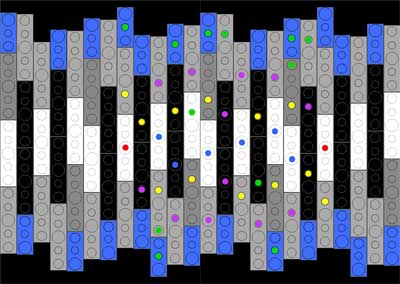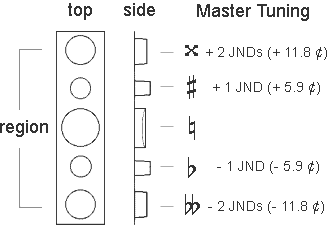



March 23, 2009

My friend Peter Hesterman asked me today how he would play Harry Partch's 43-Tone scale on the Tonal Plexus. I've been asked this question a number of times by email from people interested in Partch's scale. Usually I have answered that there are any number of ways to play it, because you can program the keys to whatever pitches you want, but the main idea behind the Tonal Plexus 205ET JND master tuning is that you can play anything you want on the keyboard without ever having to retune it or relearn fingering patterns. So, this morning I decided to make this diagram showing how Partch's scale can be played in the master tuning. Since Partch always used G as his tonic, the scale is shown here in one octave from G to G.
The harmonic structure the scale is made clearer by applying H-chroma to each pitch according to highest prime harmonics. Partch used primes 2, 3, 5, 7, and 11, and the H-chroma values for those primes are 2 = red, 3 = blue, 5 = yellow, 7 = violet, 11 = green.

For example, the blue dots show the most basic pitches of the 3-Limit in the scale. They are A, B-flat, C, D, E and F. The yellow dots show those pitches based on the 5-Limit, and so on. If you look at the dots grouped by color (which you will do automatically unless you are color-blind), focusing on the C#/Db column as the center, the symmetry of the scale becomes apparent.
The scale is given below as a list of ratios, with H-System pitch and interval names. H-System pitch names follow the form JND inflection, comma shift, letter, accidental. Inflections on the keyboard correspond to the size and shape of the key as shown below, where the large natural key is always 3-Limit:

Partch's scale maps very easily to the 41-tone circle of fifths with JND inflections, and in only two cases are double inflections used.
H-System interval names follow the form JND intonation quality, comma shift type, quality, ordinal size. The JND intonation quality is measured from the lowest limit interval within each zone. In almost every case, Partch's intervals have Perfect JND qualities; note that where it is not called Perfect, the intonation is being measured against a lower limit interval which falls in that zone. There are 51 basic 13-Limit intervals in 41 zones which have implied Perfect JND qualities in the H-System.
An example reading from the table below: scale degree 8 has a tone ratio of 10/9, the pitch is called "sharp sub-A" and the interval is called a "Perfect Small Major Second".
degree .. tone ratio .. pitch name .. interval name
1 ………. 1/1 ………. G ………. P1
2 ………. 81/80 ………. b+G ………. P.L1
3 ………. 33/32 ………. b~Ab ………. d.Sm2
4 ………. 21/20 ………. bAb ………. m.m2
5 ………. 16/15 ………. b+Ab ………. P.Lm2
6 ………. 12/11 ………. #≈A ………. P.NM2
7 ………. 11/10 ………. bb~A ………. dd.SM2
8 ………. 10/9 ………. #~A ………. P.SM2
9 ………. 9/8 ………. A ………. P.M2
10 ………. 8/7 ………. b+A ………. P.LM2
11 ………. 7/6 ………. #~Bb ………. P.Sm3
12 ………. 32/27 ………. Bb ………. P.m3
13 ………. 6/5 ………. b+Bb ………. P.Lm3
14 ………. 11/9 ………. b‡Bb ………. P.Wm3
15 ………. 5/4 ………. #~B ………. P.SM3
16 ………. 14/11 ………. #B ………. M.M3
17 ………. 9/7 ………. b+B ………. P.LM3
18 ………. 21/16 ………. ~C ………. P.S4
19 ………. 4/3 ………. C ………. P4
20 ………. 27/20 ………. b+C ………. P.L4
21 ………. 11/8 ………. b~Db ………. P.Sd5
22 ………. 7/5 ………. Db ………. P.d5
23 ………. 10/7 ………. C# ………. P.a4
24 ………. 16/11 ………. #+C# ………. P.La4
25 ………. 40/27 ………. #~D ………. P.S5
26 ………. 3/2 ………. D ………. P5
27 ………. 32/21 ………. +D ………. P.L5
28 ………. 14/9 ………. #~Eb ………. P.Sm6
29 ………. 11/7 ………. bEb ………. m.m6
30 ………. 8/5 ………. b+Eb ………. P.Lm6
31 ………. 18/11 ………. #≈E ………. P.NM6
32 ………. 5/3 ………. #~E ………. P.SM6
33 ………. 27/16 ………. E ………. P.M6
34 ………. 12/7 ………. #+E ………. P.LM6
35 ………. 7/4 ………. #~F ………. P.Sm7
36 ………. 16/9 ………. F ………. P.m7
37 ………. 9/5 ………. b+F ………. P.Lm7
38 ………. 20/11 ………. x+F ………. aa.Lm7
39 ………. 11/6 ………. b‡F ………. P.Wm7
40 ………. 15/8 ………. #~F# ………. P.SM7
41 ………. 40/21 ………. #F# ………. M.M7
42 ………. 64/33 ………. #+F# ………. a.LM7
43 ………. 160/81 ………. #~G ………. P.S8
1 ………. 2/1 ………. G ………. P8
I'm working on a feature for TPXE which will create images like those above, mapping pitches to keys using dots. It would be nice to have a version of this pitches-to-dots mapping to add to the website, but I think it would require Flash or something similar, which I don't have. The feature in TPXE will allow a library of shapes to be created, which you will be able to move around on the keyboard to see how shapes wrap around at top and bottom, which should be useful for anyone learning to play the instrument.
[ Showing 1 entry | Next entry | Show all entries ]